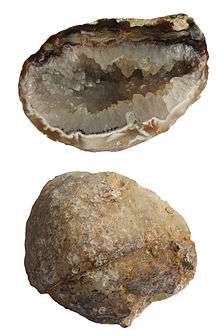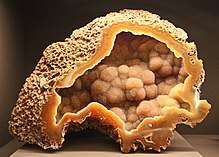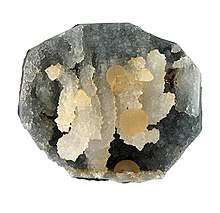Geode

Geodes (Greek γεώδης - ge-ōdēs, "earth like") are geological secondary structures which occur in certain sedimentary and volcanic rocks. They are themselves of sedimentary origin and are formed by chemical precipitation. Geodes are hollow, vaguely spheroid to oblate masses of mineral matter (which may include crystals) that form either by the filling of vesicles in volcanic to sub-volcanic rocks by minerals deposited from hydro-thermal fluids or by the dissolution of igneous nodules or syn-genetic concretions and partial filling by the same or other minerals precipitated from diagenetic water, groundwater or hydro-thermal fluids.
Geodes differ from vugs in that the former were formed as early, rounded, structures within the surrounding rock and are often removed intact. Geodes also differ from nodules in that a nodule is a mass of mineral matter that has accredited around the nodule nucleus. Both structures had the minerals contained within, deposited from groundwater or hydro-thermal processes.[1] Geodes commonly have a chalcedony (crypt-crystalline quartz) shell lined internally by various minerals, often as crystals, particularly calcite, pyrite, Kaolinite, sphalerite, millerite, barite, Celeste, dolomite, limonite, smithsonite, opal, chalcedony, and macro-crystalline quartz, the last of which is by far the most common and abundant mineral found in geodes.[2] Geodes are found mostly in basaltic lavas and limestones. The Warsaw Formation in the Keokuk region near the area where the Missouri, Iowa, and Illinois borders meet is an example of a region where geodes are abundant.
Formation
Geodes can form in any cavity, but the term is usually reserved for more or less rounded formations in igneous and sedimentary rocks. They can form in gas bubbles in igneous rocks, such as vesicles in basaltic lava's; or, as in the American Midwest, in rounded cavities in sedimentary formations. After rock around the cavity hardens, dissolved silicates and/or carbonates are deposited on the inside surface. Over time, this slow feed of mineral constituents from groundwater or hydro-thermal solutions allows crystals to form inside the hollow chamber. Bedrock containing geodes eventually weathers and decomposes, leaving them present at the surface if they are composed of resistant material such as quartz.[1] Many geodes can be found in deserts.
When cut in half, visible bands corresponding to varied stages of precipitation may at times show patterns that reveal points of fluid entry into the cavity and/or varied colors corresponding to changes in chemistry.
Coloration

Geode banding and coloration is the result of variable impurities. Iron oxides will impart rust hues to siliceous solutions, such as the commonly observed iron-stained quartz. Most geodes contain clear quartz crystals, while others have purple amethyst crystals. Still others can have agate, chalcedony, or jasper banding or crystals such as calcite, dolomite, celestite, etc. There is no easy way of telling what the inside of a geode holds until it is cut open or broken apart. However, geodes from a particular area are usually similar in appearance.
Geodes and geode slices are sometimes dyed with artificial colors. Samples of geodes with unusual colors or highly unlikely formations have usually been synthetically altered.
Prevalence

Geodes are common in some formations in the United States (mainly in Indiana, Iowa, Missouri, western Illinois, Kentucky, and Utah). They also are common in Brazil, Namibia, and Mexico.[1] Geodes are also abundant in the Mendip Hills in Somerset, England, where they are known locally as "Potato Stones."[3]
Vugs and crystal caves
In 2000 a team of geologists found a cave filled with giant gypsum crystals in an abandoned silver mine near Almería, Spain. The cavity, which measures 1.8 × 1.7 meters and is 8 meters in length, would be the largest crystal cave ever found.[4] The entrance of the cave has been blocked by five tons of rocks, and is under police protection (to prevent looters from entering). According to geological models, the cave was formed during the Messinian salinity crisis 6 million years ago, when the Mediterranean sea evaporated and left thick layers of salt sediments (evaporites). The cave is currently not accessible to tourists.
The world's largest known crystal cave or vug is Crystal Cave, a celestine geode 35 feet (10.7 m) in diameter at its widest point, located near the village of Put-in-Bay, Ohio, on South Bass Island in Lake Erie.
See also
References
- 1 2 3 "Geodes: The rocks with a crystal surprise inside!". geology.com. Retrieved 2017-12-30.
- ↑ "Geodes: What Is A Geode?". Rocks And Minerals 4 U. Retrieved 2017-12-30.
- ↑ "The Quarries". Dulcote, Somerset. Retrieved 2017-12-30.
- ↑ Amos, Jonathan (12 June 2000). "Giant Crystal Cave Discovered". BBC. Retrieved 3 September 2011.
Further reading
- Rocks and Minerals, written by Fredrick H. Pough, ISBN 0-395-91096-X
- Gerard V. Middleton: Encyclopedia of Sediments and Sedimentary Rocks. Springer 2003, ISBN 978-1-4020-0872-6, p. 221 (restricted online copy, p. 221, at Google Books)
- Walter David Keller: The common rocks and minerals of Missouri. University of Missouri Press 1961, ISBN 978-0-8262-0585-8, S. 67 (restricted online copy, p. 67, at Google Books)
- Brian J. Witzke: Geodes: A Look at Iowa's State Rock Iowa Geological Survey
- Geodes Kentucky Geological Survey (University of Kentucky)
External links
| Wikimedia Commons has media related to Geodes. |
- Indiana geode specimens, facts and stories
- Video of a geode cracking using industrial soil pipe cutter
- Geode images, locations and discussion
- Australian Museum Fact sheet
- Utah Geode Beds
- Illinois State Geological Survey. "Geodes—Small Treasure Vaults in Illinois" (PDF). Archived from the original (PDF) on 2007-09-27.